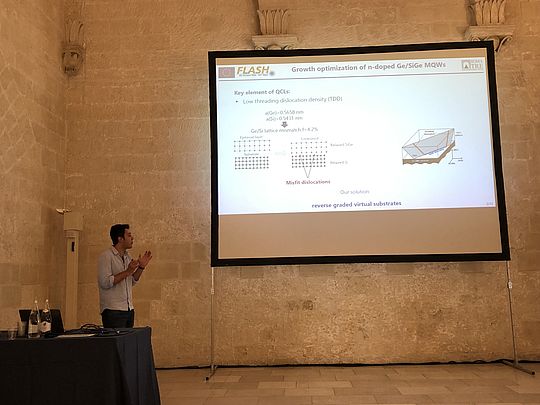Michele Montanari giving the talk "n-type Ge/SiGe Multi Quantum-Wells for a THz QCL" at TERAMETANANO conference held in Lecce.
Abstract
Theoretical predictions indicate that the n-type Ge/SiGe multi quantum-well system is the most promising material for the realization of a Si-compatible THz quantum cascade laser (QCL) operating at room temperature [1, 2]. With the view to realizing a Ge/SiGe QCL, we present the optical and structural properties of n-type strain-symmetrized Ge/SiGe asymmetric coupled quantum wells (ACQWs) grown on Si(001) substrates by means of ultrahigh vacuum chemical vapor deposition [3]. Extensive structural characterization obtained by scanning transmission electron microscopy (STEM), atomic probe tomography (APT) and X-ray diffraction shows the high material quality of strain-symmetrized structures (up to 5-micron active region thickness) and heterointerfaces (featuring interface roughness below 0.2 nm), down to the ultrathin barrier limit (about 1 nm). By performing THz absorption spectroscopy measurements combined to theoretical modeling on different ACQWs (varying well width or barrier thickness), we unambiguously demonstrated control over inter-well coupling and electron tunneling [3]. Motivated by the promising results obtained on ACQWs, which are the basic building block of a cascade structure, we investigate electroluminescence on a Ge/SiGe THz QCL design, optimized through a non-equilibrium Green’s function formalism [4]. Simulations show that, due to the non-polar nature of SiGe alloys, the maximum gain of a Ge/SiGe QCL is much more robust against the temperature increase with respect to III-V based devices. Moreover, the interface roughness values measured on our samples are predicted to allow the possibility to achieve gain overcoming the losses of double-metal waveguides at room temperature. The results obtained represent a key step towards the realization of a Si-based QCL.
References
[1] D. J. Paul, Laser Photon. Rev. 4, 610 (2010).
[2] K. Driscoll, and R. Paiella, J. Appl. Phys. 102, 093103 (2007).
[3] C. Ciano et al., Phys. Rev. Appl., 11, 014003 (2019).
[4] T. Grange et al., Applied Physics Letters 114, 111102 (2019).
